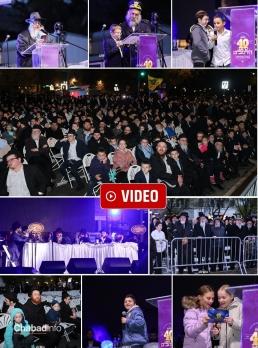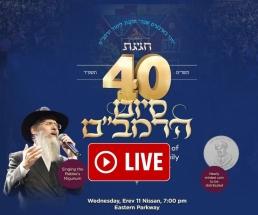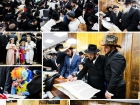Vayeira: Seeing Angels
From the desk of Rabbi Nissim Lagziel, Mashpia in Oholei Torah: Some people speak with their minds. Some people speak with their hearts. Some people speak with their mouths. And some people speak with…their hands! • Full Article
By Rabbi Nissim Lagziel
Some people speak with their minds.
Some people speak with their hearts.
Some people speak with their mouths.
And some people speak with…their hands!
DIFFERENCES IN APPEARANCES
We read parshas Vayeira this week, which begins with Hashem revealing Himself to Avrohom Avinu and the visit of the three angels. Chof Cheshvan falls out next Monday; it’s the birthday of the Rebbe Rashab. The connection between these two things, the beginning of Vayeira and the Rebbe Rashab’s birth, are seen in the well-known story, related in the Hayom Yom for 9 Cheshvan:
When my father was four or five years old he went to his grandfather, the Tzemach Tzedek, on Shabbos Vayeira, and began to cry as he asked, “Why did Gd show Himself to our father Avraham – but He does not show Himself to us?” The Tzemach Tzedek answered him: “When a tzaddik decides at the age of ninety-nine years that he should be circumcised, he deserves that Hashem should appear to him.”
The G-dly revelation of the name Havaya is something that comes up in Chassidus thousands of times, each time in a different way. Sometimes the name Havaya represents this world and sometimes another world; sometimes it represents sefira A and sometimes sefira B. It’s very possible that many who study Chassidus are frustrated by the lack of clarity on this subject.
After all, every time we want to say that something unprecedented happened, we are likely to describe it as a revelation of the name of Y-H-V-H (or as we say in Chabad, Havaya).
How many times is this “Havaya” meant to be revealed? How is it unprecedented every time? If you were to ask the average citizen, he would say it sounds like a marketing ploy by the ad companies. Every time it’s “an unprecedented sale,” “for the first time in history,” “don’t miss this once in a lifetime opportunity.”
Since when is the name Havaya part of the G-dly marketing process? What exactly is going on here?
Let’s narrow the question down. Already in the previous parsha, Lech Lecha, the Torah tells us two times (once in chapter 12:7 and once in 17:1) about G-d’s revelation to Avrohom with the words, “And Y-H-V-H appeared to Avrohom.” What’s new about the beginning of parshas Vayeira?
Let’s continue. At the beginning of Va’eira (don’t get confused, that’s “Va’eira” and not “Vayeira”) we read about the G-dly revelation to Moshe Rabeinu before the exodus. G-d declares (Shemos 6:6), “Therefore, tell the Jewish people I am Havaya.” According to Chassidus, this is meant to explain to Moshe that the entire purpose of the difficult exile in Egypt is in order to bring the Jewish people to the desired revelation… the name Havaya! But didn’t we get that back in Avrohom’s time? What was new about this at the exodus and at Mattan Torah?
If that’s not enough, Chassidus quotes a verse from Yeshaya (40:5) hundreds of times, that in the era of the Geula “and the glory of G-d will be revealed and all flesh together will see that the mouth of Havaya has spoken.” Havaya once again. Nu, what’s new about this?
TO SEE PAST THE GARMENTS
In an amazing maamar, the Rebbe Rashab explains the difference between these four revelations/situations: the G-dly revelation to Avrohom before the bris mila, after the bris mila, the revelation to Moshe at Mattan Torah and the revelation in the true and complete Geula.
The basis of the explanation is the Talmudic concept of “two which are four.” This means the G-dly revelation is comprised of two aspects, each of which is divided into two, thus creating four types and levels of revelation. At each level, world or sefira in the upper worlds there is a division into two levels, the inner (pnimiyus) and the outer (chitzoniyus). The “inner” signifies the thing itself, while the “outer” represents the ramifications deriving from the thing itself, the bottom line, the practical implications.
Man’s receiving of every revelation depends on his ability to apprehend, understand and internalize the revelation. Sometimes, a person is capable of so completely identifying with a given revelation that he does not need any explanations which, in Chassidus, are called levushim (garments), and sometimes he needs those levushim and without them he won’t understand anything.
According to this, every level or revelation can be spoken about in four ways, pnimiyus and chitzoniyus with a levush and without a levush. Or, to be more precise and in descending order; the highest level is pnimiyus without a levush. Below that is pnimiyus with a levush. If a person cannot receive pnimiyus at all, then comes the third level chitzoniyus without a levush. At the bottom of the ladder is chitzoniyus through levushim, curtains and constrictions.
Let’s explain these in simple terms.
The first difference between pnimiyus and chitzoniyus is that pnimiyus cannot be conveyed through words and sentences. This is something that cannot be given over. It’s too deep, too internal and on a personal soul level for us to be able to transmit it. This is the level which the recipient senses from within himself, feeling on his own by becoming so unified and identifying with the higher level.
The highest level, revelation of pnimiyus without levushim is similar to a person’s revelation to himself. It’s knowing yourself as only you can, it’s knowing your own true inner reality, the essence of your own being on the deepest level of human awareness. Obviously, on this level, man does not need explanations. Nobody explains himself to…himself. Levushim/explanations are only for an outsider, for someone else, not me. A person in regards to himself understands and is cognizant of his own essence without the need for words, explanations, or clarification. He is simply himself!
Below this is the level of revelation of pnimiyus through levushim. We already said that pnimiyus cannot be conveyed through explanations or descriptions. It’s something that can only be felt. On the other hand, sometimes the mashpia can impart a bit of what he is going through and the recipient can sense and internalize this through motions, facial expression, the subtle hints the mashpia conveys. It’s beyond words and beyond explanations. It’s an inner sense which he feels because he so close to the person who is being revealed.
A talmudic example of this is (Shekalim 7b), “Someone who says something in the name of the one who said it should see the person who said it as though he is standing before him.” How will that help? Will it contribute toward explaining things and understanding them?
The answer is, yes! In the words of the Alter Rebbe, “by seeing the face of the mashpia shines forth [to the student] from the essence of his wisdom, not just what he is mashpia to others.” By looking at the teacher while he teaches, a person can sense, internalize and understand deeper things within the ideas being taught which the teacher cannot say in words.
Another example cited as a possible analogy in Chassidus is the understanding the depths of a line of reasoning by way of the finger movements or the body language of the teacher, which say more than his mouth can explain (as in the opening joke).
Then comes the chitzoniyus, first without levushim and if all else fails, with livushim. As an example for the difference between the two and the clear division between chitzoniyus and pnimiyus, would be like understanding a shiur on a talmudic topic. The teacher explains to the best of his intellectual prowess the intricacies of the Talmudic give and take. He outlines the question and answer, the proof and its refutation, until he arrives at a conclusion. The student doesn’t need to “connect” to the subject. He doesn’t need to be “mekushar” to the teacher on a soul level. If he merely pays attention, listens, and concentrates, he is likely to understand because it is unadorned intellect, pure logic (no “garments” needed). The subject might be complicated, long and exhausting but it’s still logical, a rational explanation. Whether you relate to it or not, whether you identify with it or not, the logic is understood by a rational mind.
As long as we are talking about someone with a sufficient portion of intellectual capacity, someone with sufficient intelligence and focus. But if the student is on a lower level and he cannot grasp all the intricacies of the subject, then the teacher needs to condense things in brief, conclusive sentences, statements of pragmatic, bottom line, practical halacha in the case in question without convolution and reasons, without divergent views and opinions. Short and to the point. This will be an example of the fourth and last level: chitzoniyus through levushim.
Back to our subject, Avrohom only attained the revelation of chitzoniyus. Before the bris, through levushim and after the bris without levushim. Moshe (and the Jewish people in general) attained a revelation of pnimiyus through levushim at Mattan Torah. And the level we all strive for is a revelation of pnimiyus without levushim. That will happen when the Geula arrives, the time when we will so identify with the G-dly revelation, on a level beyond words and explanations, in a place so deep within the soul, in which we will feel Him and He us.
We will be 100% united with our Creator without needing teachers, projections and slides. It will be a time when (Yirmiyahu 31:33)“And no longer shall one teach his neighbor or [shall] one [teach] his brother, saying, ‘Know Havaya,’ for they shall all know Me from their smallest to their greatest…”
TO CONCLUDE WITH A STORY
We will end with a story that can explain a bit about the revelation of pnimyus without levushim, as told by the protagonist, Rabbi Tzvi Hersh Weinreb.
I didn’t consider myself a Lubavitcher, but I lived in Crown Heights for a short time after I got married. I would attend the Rebbe’s farbrengens from time to time, but my relationship was always from a distance.
I mention this because of what happened later on.
Three years after we married, my wife and I moved away to Silver Spring, Maryland, where I attended the University of Maryland. I received a PhD in psychology and began working as a psychologist in the local school system. Besides this, I used to give classes in Talmud—one on Shabbos afternoon for the general public, and one on Tuesday night for a smaller group who wanted to learn on a deeper level.
I was in my early thirties, so I suppose I was too young for a midlife crisis—or maybe I arrived at a midlife crisis earlier than most people—but around this time, I was torn with a number of very pressing questions: Should I stay in Torah learning, or should I continue in psychology? And if so, how should I further my career? Should I move into private psychotherapy work or accept an offer from one of the county social service organizations in the area? Also, I wasn’t sure what was best for my children in terms of educational options in Silver Spring.
In addition to all these dilemmas, like everybody else I guess, I had my own questions of faith and trust in G-d, as well as some philosophical questions. I was in a state of uncertainty. All these questions had me depressed, and I was unsure what to do or where to go. I spoke to various close friends, and one of them – a Chabad Chassid – suggested that I visit the Rebbe. And so it was that in February of 1971 I called the Rebbe.
The Rebbe’s secretary answered the phone in English, with a simple “Hello, who’s this?” Now, as I was talking to the secretary, in the background—I recognized his voice from the farbrengens I had attended—the Rebbe was asking in Yiddish, “Who’s calling?” I replied, “Ah Yid fun Maryland” (“A Jew from Maryland”).
I told the secretary that I have many questions which I would like to discuss with the Rebbe—questions about what direction my life should take, questions regarding my career, questions of faith… I explained that I was at a very uncertain stage in my life and I didn’t know where to turn. I spoke in English and, as I was talking, the Rebbe’s secretary was repeating and paraphrasing my words in Yiddish – I imagine he was doing this so that the Rebbe should hear. And then I heard the Rebbe say in the background, in Yiddish: “Tell him that there is a Jew who lives in Maryland that he can speak to. Der yid hayst Veinreb—his name is Weinreb.”
The secretary asked me, “Did you hear what the Rebbe said?” Now, I couldn’t believe my ears. I knew for sure I had not given the secretary my name, but the Rebbe had just said my name! I was taken aback, and I wanted to hear it again. So when the secretary asked whether I heard, I said no. The secretary repeated the Rebbe’s words to me: “S’iz doh a Yid in Maryland mit vemen er zol redden. Zayn nummen iz Veinreb.” (“There’s a Jew in Maryland whom he should talk to. His name is Weinreb.”)
So I replied, “But my name is Weinreb!”
And then I heard the Rebbe say,“Oib azoi, zol er visen zayn az amol darf men reden tzu zich.” (“If that’s the case, then he should know that, sometimes, one needs to speak to himself.”)
The secretary also seemed stunned by what was taking place. He just stopped, and I could hear his breathing. And then he said to me, “The Rebbe said that sometimes it’s best to talk to yourself. Isn’t your name Weinreb?”
“Yes, my name is Weinreb, but maybe the Rebbe means a different Weinreb.” “No, the Rebbe’s saying, ‘Talk to Weinreb,’ and he explained that you must to talk to yourself.”
I thanked him very much, and the call ended with that.
Since 1971, there have been times when I faced difficult questions in life, and before I sought advice from anyone else, I would listen to my inner voice. I would set aside time to first study some of the Rebbe’s teachings – like Likkutei Sichos – in order to connect again, and then I’d follow the advice he gave me: to talk to myself.
Good Shabbos!
70
Join ChabadInfo's News Roundup and alerts for the HOTTEST Chabad news and updates!









































